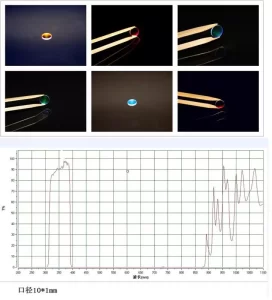360nm Bandpass Filter
Thickness: 1.10mm
CWL: 808nm+/-5nm
FWHM: 20nm
Transmission: 88%
About the bandpass filters
Filters are designed by their manufacturers to transmit or absorb different wavelengths of light. And they are widely used in scientific experiments and industrial applications where that change is necessary.
A Band Pass Filter is designed to pass signals only in a certain band of frequencies while rejecting all signals outside this band. Unlike the low pass filter which only get through signals of a low frequency range, a Band Pass Filters passes signals within a certain “band” or “spread” of frequencies without distorting the input signal or introducing extra noise.
In a receiver, a bandpass filter allows signals within a selected range of frequencies to be heard or decoded, while preventing signals at unwanted frequencies from getting through. A bandpass filter also optimizes the signal-to-noise ratio and sensitivity of a receiver.

How do bandpass filters work?
Unlike the low pass filter which only pass signals of a low frequency range or the high pass filter which pass signals of a higher frequency range, a Band Pass Filters passes signals within a certain “band” or “spread” of frequencies without distorting the input signal or introducing extra noise.
Why bandpass filter is used?
Bandpass filters are widely used in wireless transmitters and receivers. The main function of such a filter in a transmitter is to limit the bandwidth of the output signal to the band allocated for the transmission. This prevents the transmitter from interfering with other stations.

Our Ordering Process
Send us your request with detailed specifications
Receive a commercial offer with terms and costs
After your approval, we handle manufacturing, quality control, and shipping
📦 Shipping
3-5 days in EU, from 10 days to USA
💳 Payment methods
Cash, Bank Transfer, Cards (Visa, Mastercard, Amex, Discover) and PayPal
💬 Questions?
Contact us via WhatsApp, phone, live chat or email



